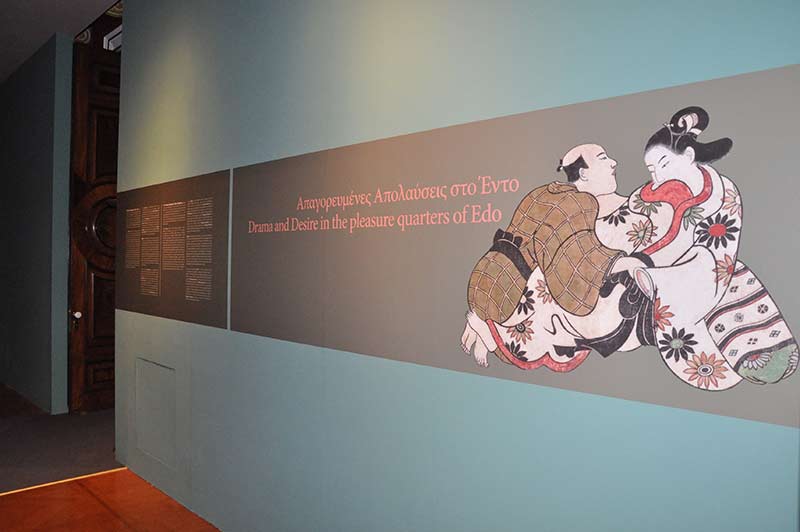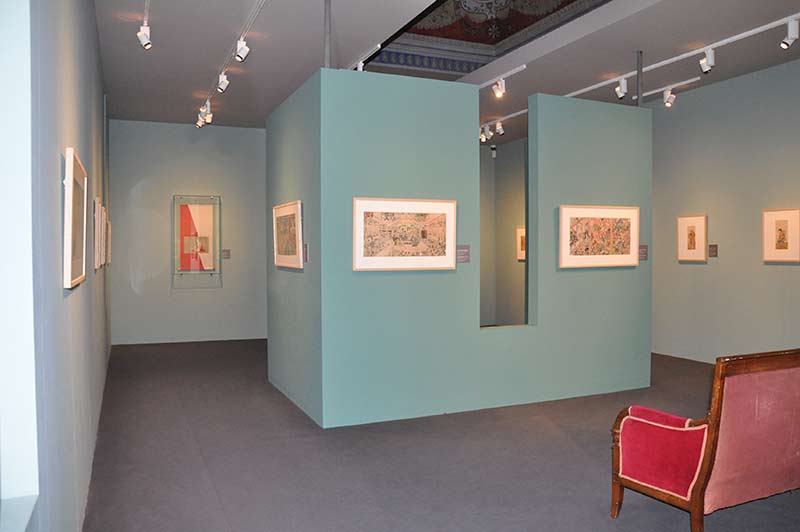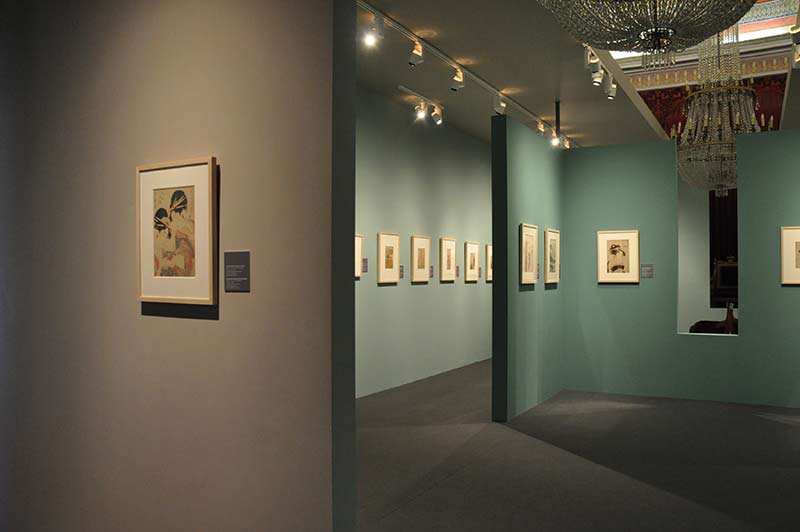The Corfu Museum of Asian Art was pleased to organize the temporary exhibition entitled ‘Drama and Desire in the pleasure quarters of Edo’, which was open to the public from 8th of April 2014 until 10th of June 2014. Curator of the exhibition was Despina Zernioti, Director of the Corfu Museum of Asian Art.
The exhibition included 70 Japanese Ukiyo-e woodblock prints, which were first exhibited in Paris in 2011 in collaboration with the Maison de la Culture du Japon à Paris and the Sainsbury Institute for the Study of Japanese Arts and Cultures. The works, unique examples of Japanese art from the 17th to the 19th century belong to the collection of the Museum’s founder Gregory Manos (1850-1928). The exhibition was enriched by 3 hanging scrolls, particular aesthetic and artistic value, coming from private collection.
The term Ukiyo-e, ‘pictures of the floating world’, refers to images depicting everyday life, especially scenes from the pleasure quarters of Edo. Rich clients commissioned artists to produce hanging-scroll paintings (nikuhitsu), while, a wider audience enjoyed woodblock prints during the Edo period (1615-1868). The prints could be produced quite cheaply and in large quantity as a simple memento. The earliest prints were simple black and white taken from a single block. Sometimes they were coloured by hand, a process which was quite expensive. In the 1740s additional woodblocks were used to print the colours rose and green. The technique of using multiple colour woodblocks was perfected in 1765. Despite periodic attempts by the government to strengthen censorship, the Ukiyo-e art flourished during the late 18th century. The most frequently depicted subjects were famous beauties (bijin), sensual pleasures (shunga) and well-known kabuki actors. All derived from the pleasure districts of Edo, where men of all classes went to escape the rigid hierarchy of feudal society.
The term Bijinga, ‘pictures of beautiful women’, refers to portraits of famous seductive courtesans, geisha and beauties, modeling fashionable hairstyles and stylish textiles. Suzuki Harunobu (1725?-1770) experienced tremendous success with the extremely detailed portraits of graceful figures and slender beauties dressed in colorful kimono. The work of Torii Kiyonaga (1752-1815) was characterized by slender female figures that seemed to be detached from their natural landscape. Kitagawa Utamaro (d. 1806) dedicated his entire artistic life to exploring female beauty and his sensitive portrayals in gros plan (okubi-e) are regarded as the finest and most evocative bijinga. Utagawa Toyokuni (1769-1825) captured the world of bijin with great clarity, while Utagawa Kuniyoshi (1797-1861) did remarkable pictures of beautiful women with the use of vibrant colours and striking compositions.
Shunga, which literally means ‘spring pictures’, is a term used for the erotic Japanese paintings, prints and illustrations. From the 12th century, painted shunga handing scrolls (emaki) became an established art-form among the priesthood, aristocracy and samurai classes. In the 17th century, with the spread of woodblock printing, erotic art became freely available and popular within the classes of city merchant. In 1765 the artists exposed the human anatomy in full detail, without any modesty but always with tender and in good taste. The Yoshiwara pleasure quarter was their main source of inspiration. During the 20th century, the production was gradually reduced and the art of shunga became taboo. However, in recent years there has been a revival of appreciation as a treasured form of Japanese art.
The famous Japanese Kabuki theatre was also a popular subject of woodblock prints. The prints depicting actors (yakusha-e), wearing magnificent costumes in full make-up, promoted not only theater productions but also the actors themselves. In the 1760s Katsukawa Sunsho (1726-1792) was best known for revitalizing kabuki portraiture. Toshusai Sharaku, one of the most mysterious artists in the history of Japanese art, suddenly appeared in 1794 and designed portraits of kabuki theatre actors against a dark background. His brief career was over just 10 months later. Sharaku’s prints depict in a revolutionary way the individual features of an actor and the characteristics of the role. Finally, Utagawa Toyokuni (1769-1825) was popular for his works with actors, who he saw himself acting on the stage.





